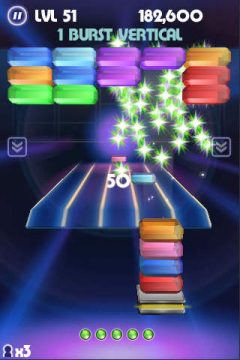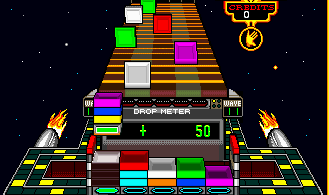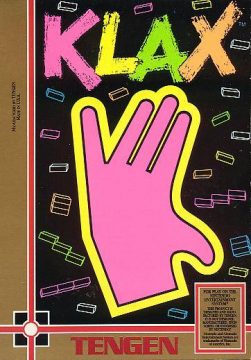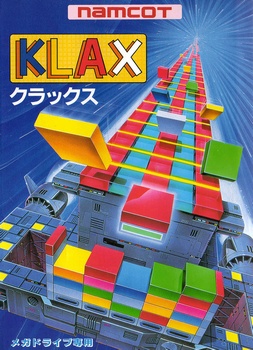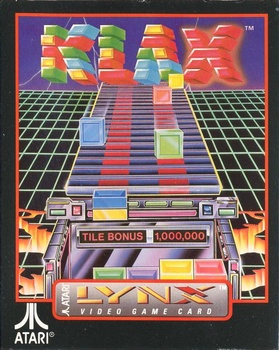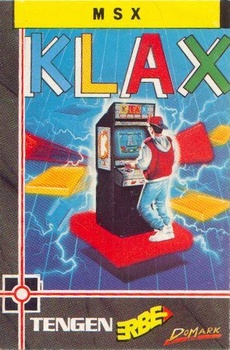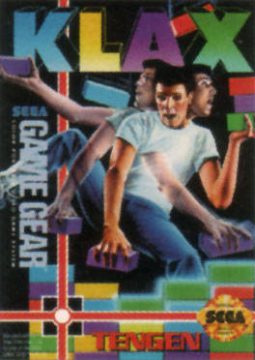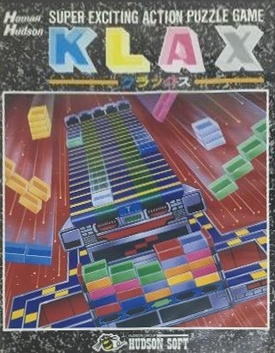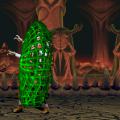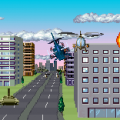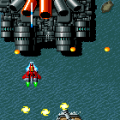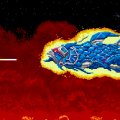n the arcades, games about blocks falling continuously were often as readily available as they were on the handhelds. Several companies were passing around Tetris through every facet of gaming, while Sega had reasonable success with Columns. Atari Games, the arcade division of Atari behind such titles as Gauntlet was one of the many companies tangled in the legal debacle that was Tetris. Instead of trying to tangle the rights out of Nintendo once more, however, they’d simply go on to make a puzzle game of their own. And while it might not quite be as legendarily addictive as Alexy Pajitnov’s game, but it’s got enough of its own unique twist that it’s still worth playing. The attract mode states “”It is the nineties and there is time for Klax”. It is the 2010’s, and there is still, indeed, time for Klax.
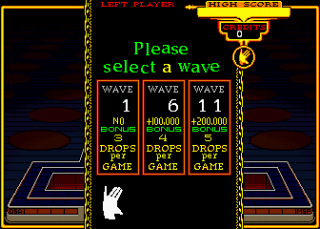
In Klax, you’re still dealing with a bunch of blocks moving towards the bottom of the screen, taking the form of the same square tile in different colors. Instead of controlling the pieces themselves, however, you control a paddle at the top edge of the well each piece is constantly moving towards. Having a tile fall on your paddle will pick it up, and hitting the main button will drop the topmost tile on your paddle into the well below. Matching three tiles of the same color in a horizontal, vertical, or diagonal row makes a “Klax”, clearing out the tiles you match and earning you points. Fancier matches earn you more points, so if you really want the best scores, you’ll want to go for the diagonals.
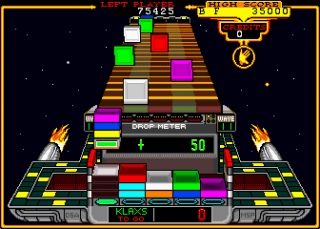
While having your well fill up entirely will end your game, that’s actually not the biggest danger you’ll generally face. Any tiles that you fail to catch with your paddle will fall into the waiting void below, costing you one of your drops. You can also only hold five tiles at once on your paddle, and trying to hold any more than that will make a piece drop, as well. You only get from three to five drops, depending on your difficulty level, and once you run out, your credit’s over. In a somewhat weird twist, however, this won’t instantly end your game, since you can reset the level you’re on as many times as you want, provided you got the credits. While you might think having that many chances to screw up sounds pretty lenient, losing one block often means losing some more right after it, and you only get your drops back at the end of every fifth wave.
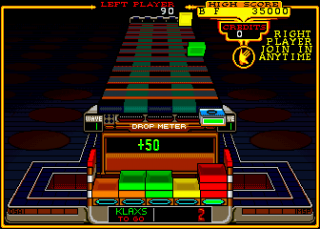
Klax also differentiates itself from your average falling tile game of the time by actually having an end goal. There’s a total of 100 waves to the game, each of them having a different challenge in order to clear it. Some waves make you get a certain number of Klaxs, while others will only want specific kinds of Klaxes, like a wave that makes you get a certain number of diagonals. You’ll have waves that’ll make you earn a certain number of points, while others will make you catch a certain number of tiles to progress. You might have one wave about making as many matches as fast as you possibly can, while others test how much you know about scoring techniques, so it basically means that every type of wave has you thinking in a different way. It’s a little bit of extra variety that helps keep a game that goes for that long from getting too repetitive, too quickly.
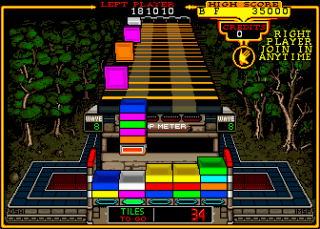
Instead of the tiles themselves getting faster as you go, the game simply sends more tiles your way at once, with some levels immediately sending a whole bunch of tiles at you from the start. There’s something wonderfully nerve wracking than watching ten or so tiles avalanching towards you, forcing you to try and think about where each one could possibly go, as the well below keeps piling up and up. You can press up on the joystick to launch blocks up back into the air, but this only gives you a moment’s reprieve, as they’ll quickly come rolling back down along with the dozen or blocks heading your way. It’s a rather different feeling to something like Tetris, where later levels focus more on reflexes, as the hardest levels of Klax involve all sorts of split decisions and planning ahead. It’s difficult, yes, even frustrating, but it still manages to make you want to keep coming back to it and trying to do better.
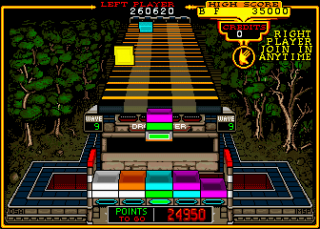
If you’re feeling particularly cocky, you can skip ahead five or ten waves at certain points in the game, either when starting a new game or at the end of every fifth wave you clear. While doing this will give you a big points bonus, it also means that you’ll be facing much harder waves, so it depends on how good you think you are. While the first few waves are pretty easy, the difficulty curve ramps up pretty quickly, to the point that’ll it’ll take several attempts to clear most of the waves beyond the first ten or so. It’s a nice addition, at least, since you won’t have to start all the way from the beginning once you’ve gotten to the point that you’re good enough at the early levels.
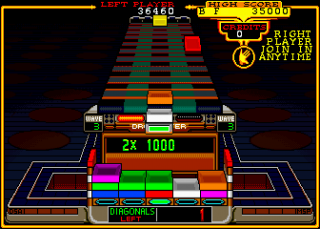
There’s also a few tricks to boost your score, as well, like making Klaxes that are four, or even five tiles long. There’s also a thing you can do where you can still drop tiles as matches are being cleared off of the screen, and doing this makes a score multiplier for your next Klax, which is even more lucrative when you can make a chain reaction with falling tiles. A lot of these tricks come into play with wild tiles, which count as a match no matter what color line they’re dropped into. They’re pretty rare, but they be exceptionally useful when things get rough.

Klax starts off with a pretty high learning curve, even from the early waves, and it’s pretty easy to end up getting overwhelmed. The game doesn’t give you get many breaks, and the general pace is often just so frantic that keeping up with the sheer flood of blocks can be pretty tough. Unlike most games of its ilk, however, one failure doesn’t mean the end of the game, so you’re free to keep cracking at whatever wave’s stumped you for as long as your credits hold out. It definitely helps scratch that “one more game” feeling that all the best puzzle games do so well.
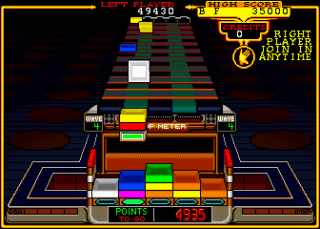
The game also features a two player mode, although the way it’s used is a little unusual. There’s no way to interfere with the other player, and it actually seems like the two players are involved in completely different games. From the way it works, it seems more like a way to have two different players play two different games on the same monitor, which is certainly a wasted opportunity.
While the graphics aren’t outstanding, for a puzzle game, they work pretty well. The only real issue is the tilted perspective the game takes, which sometimes makes seeing where certain blocks are a little tricky, especially when the blocks are coming down particularly quickly. There’s a nice touch where the background changes every few waves, going from a space background, to something that looks like a drive-in theatre, with a few others as the game progresses. There’s an interesting touch with the sound effects where each type of block makes a different sound when they move downwards, which helps give a little hint on what’s coming up. There’s no music, however, which can make things sound a little empty at times. The game does make use of a lot of digitized speech, however, including a female announcer who particularly approves of fancy Klaxes.
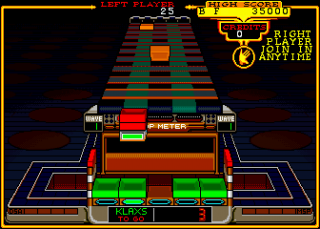
Klax has enough of its own unique flavor that it stands out pretty well among the glut of falling block games, as tough as it is. It’s not quite going to dethrone Tetris, but it makes a fantastic alternative that does far more to differentiate itself than your average Tetris clone. No matter the decade, you should go out and make time for Klax.
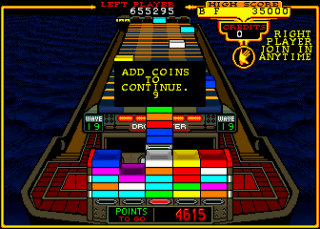
Klax came out on an absurd number of consoles and computers, so there’s plenty of ways to sit down and play it and bring it with you. Most of these ports tend to be fairly close to the arcade version, with only a rare few that are especially that much better or worse than the original arcade release. The biggest problem with the home releases is that most of them give you a limited number of credits, which, while serving as a motivation to play better, makes it a lot harder to make progress outside of the initial waves.
The Genesis version, released by Tengen, is pretty close to the arcade version, aside from some missing sound effects. It’s also missing the two player option, although that isn’t really much of a loss. It also includes multiple difficulty settings, which helps lower the learning curve considerably. It also has an option for music, which activates a single track that plays about five seconds before looping. It’s not loud enough to be considerably annoying, but you’re better off playing without it.
The Japanese Mega Drive version, released by Namco, is an entirely different port. If you’re curious as to why there’s two ports to the same console, by entirely different people, Generation 16 put out an interesting video that goes into the details. The Namco version features entirely redrawn graphics from the arcade version and an entirely new set of sound effects and voice clips, as well. In terms of gameplay, it feels somewhat slower than most other versions. When you reach the harder levels, it’s a little more difficult to notice, but it might be a little hard to get used to, if you’re comparing it directly to the arcade version.
This version also offers an actual versus mode, as opposed to having two players share two entirely separate games. This mode involves both players being given a specific sort of wave, and the first person to complete the wave or not run out drops wins the round. The first player to four wins takes the match. It’s a nice addition, especially considering that the original game didn’t even have anything like this, although it’s not quite as in depth, as, say, your average Puyo Puyo.
The TurboGrafx-16 version might be the most accurate console version of them all, and it looks and sounds almost exactly like the arcade. It doesn’t offer much in the way of special features, but it’s so accurate that it doesn’t really need to.
The Master System version plays pretty closely to the arcade version, but it has a lower color pallete. Among other things, this makes tiles of similar colors a little harder to tell apart in certain situations, which is a little annoying. Other than that, it’s a pretty basic port with not many extra features to speak of, aside from minor things like changing the tile colors or the speed of your paddle. The Game Gear version is practically identical, aside from a smaller screen size.
The Atari Lynx version is actually one of the closest ports there is to the original arcade game, which is especially impressive, considering it’s on a handheld. The only thing it doesn’t quite replicate are the different backgrounds, given the lack of screen size for them. It even manages to include all the digitized sound effects, which not even the Genesis port was quite capable of. Aside from that, though, it’s a pretty basic port with no real extras besides multiple difficulties. The paddle also feels somewhat more sluggish, as well, although It’s not bad enough to kill the rest of the port.
The Atari 7800 version was never actually released, although the prototype is still floating around on the internet. It’s not quite as smooth as certain other versions, nor is it as pretty. It has the same issue some other 8-bit versions of the game have where the colors aren’t quite as distinct as they should be, which can become a bigger issue on higher levels. It’s still a pretty faithful port, even if it isn’t quite as responsive as it is on more powerful consoles. Interestingly, this port has three “impossible” waves, given to you after you beat the original hundred waves. These extra difficult waves involve either making certain kinds of Klaxes with a limited number of colors available, or making a massive amount of points on a level that the game straight up tells you is cheating. It’s a nice touch, and the extra levels make this version worth seeking out, if you can beat the game in the first place.
Yes, there was an Atari 2600 version, despite the fact that this port came out more than a decade after the release of the console. As you’d expect, it’s not particularly pretty to look at, nor does it sound all that great. But somehow, the entire thing manages to function, as cut down as it is. The biggest problem with this port is that certain colored tiles are incredibly hard to spot as they’re coming down, which means you may end up missing a few through no real fault of your own. Because of this, it’s not one of the best ports, but the fact that they made it run without it becoming a total disaster like, say, Double Dragon, means it’s at least worth checking out.
The NES version, one of Tengen’s many unlicensed games for the system, definitely stands as one of the better 8-bit ports. It even has the two player option, although it only works the same way as it did in the arcade version. This version actually offers a selection of music tracks, and they’re all pretty unusual, although they’re at least intense enough that they’re generally appropriate to the puzzle action. One source describes the music as “speed metal”, and there’s probably not much of a better way to describe it. This version also has a weird minigame called Blob Ball, which is basically an endless, single-player Pong, where you use a paddle to bounce a ball and keep it from hitting a wall of spikes. The manual itself admits there’s no relationship to the rest of the game, nor is there any real reason it’s there. At least they’re honest about it.
The Game Boy port released for Western territories by Tengen is a pretty no-frills port that does its best to look like the original arcade version. You might be wondering if a game that relies so much on different colors is difficult to play on a Game Boy. Truthfully, it is, but they at least tried to get around that issue by using different patterns on each tile, instead of colors. Unfortunately, the patterns aren’t distinct enough once the game really gets going. Factor in the blur of the Game Boy, and you’ve got problems.
The Japanese Game Boy port, developed by Hudson Soft, is an entirely different, and superior, port. Instead of trying to replicate the perspective of the arcade version, this version simply has the entire game on a simple flat view. This makes this version a lot easier to play, especially since the patterns the tile use are a lot more distinct, helping them stand out far more on the Game Boy’s blurry screen. While it’s still a pretty basic port, it’s overall a much nicer experience than Tengen’s subpar port.
The Game Boy Color version is one of the best ports of the game there is, easily on the level of the Lynx version when it comes to the handheld versions of the game. It’s pretty close to the arcade version, even managing to include all the digitized sound effects. The only real issue is that the tile colors are a little darker than they should be, which means it’s not always easy to pick them out when you’re dealing with a full bin. This version also offers a “Freestyle” mode, which brings you to one never ending wave that’s good for practicing setting up certain Klaxes. There’s not much point to it besides that, but it’s nice to have.
What’s particularly interesting about this port is that it actually offers a password system, which let you instantly warp to any fifth wave in the game. There are other passwords as well, two of which explain the original story to Klax. One of these details the game’s creation at Atari, and the other explains how Klax was invented in the 1940’s, and involved a conveyer belt cranked by street urchins. Which one is the real story? We may never know. There’s even a few hidden minigames, including Snake, Minesweeper, and a particularly weird minigame that lets you put the programmers’ heads on different bodies. It even includes a hidden marriage proposal, to which the recipient accepted.
The Game Boy Advance version, bundled with Marble Madness on the same cartridge, is pretty much just the arcade game with absolutely no extras. Even if that’s all it is, it does pretty well at that, with only a few minor complaints. The movement of the tiles is a little blurry, which would probably be compounded on the screen of an older GBA, and the voice samples are surprisingly muffled. Beyond that, it’s a pretty serviceable handheld port that stands up at the top of the handhelds. Unfortunately, the same can’t be said for Marble Madness, which is apparently missing an entire level.
The Amiga version starts off with a new voice sample of somebody speaking the game’s introductory line, along with an entirely unique theme tune composed by Matt Furniss. It’s a serviceable port, with no real frills, but the smaller color pallete makes everything look incredibly dithered. At times, this can make telling certain colors apart more difficult, which can lead to frustration later on. The Atari ST version looks and plays about identically to the Amiga version, with the only major difference being a bunch of new songs written for this version, also by Matt Furniss. It’s missing out on the speech samples, but the exclusive music is nice enough that it makes a nice trade.
The DOS version resembles the Amiga and ST versions the most, at least, when you’re using the VGA option, and much like those versions, is a pretty standard port with no real oddities. You also have the option to play in CGA mode, however, which renders the game entirely in shades of blue and pink. Surprisingly, the tiles are still more visible than some of the other versions of the game. Unfortunately, however, you can’t change the fact that the sound effects only come from the PC speaker, which makes a horrible buzzing sound any time you make a Klax. If your ears are conditioned to such a thing, it’s not an awful port, though.
The C64 version may actually be the worst port of them all. It has the same issue of having dark backgrounds that make dark tiles hard to see, which is an issue that plagues far too many of these ports. Even that would be forgivable if the paddle wasn’t entirely too sensitive to even the slightest touch of the controller, making it slip back and forth above the bin way too easily. Besides that, it’s generally a pretty sluggish port overall, making it generally one of the worst ways to play the game, given its myriad of issues.
At first glance, the Spectrum version seems surprisingly polished, far more so than the C64 version ever was. And aside from the usual issue of a limited color pallete making telling certain tiles apart difficult, as always seems to crop up, it actually does pretty well. It even manages to fit in a few speech samples along with the music previously heard in the ST version. The thing that kills this port, however, is that having more than about two tiles coming down towards you will start to slow things down, and a couple of more from there starts to make the game chug heavily. On the later levels, this pretty much means you’re going to spend entire waves in slowdown. It’s a shame, because it could have been close to being a great port.
The Sam Coupe version, at first glance, has a much closer resemblance to the Amiga and ST versions, although it’s all laid out in a way that’s not quite like any other port. It would be a pretty serviceable port with no real extras, if it weren’t for the fact that this port suffers the same issue as the Spectrum version. Too many tiles at once, and the game slows to a crawl. It includes a new title track not found on the other versions, but the slowdown still kills this particular version.
The MSX version, somewhat unusually not in the hands of a Japanese developer, considering the market for the machine, is without a doubt the worst port of them all. Take the Spectrum version, and then make it so the game doesn’t even need to have a lot of action going on to go right into Slowdown Town. On the first wave, it takes the first tile literally an entire ten seconds to go from the top of the screen towards the well. And it only gets worse from there. As you can imagine, fun will not be had.
The BBC Micro version is, from the start, quite clearly a case of a system trying valiantly to play a game it just wasn’t meant to handle. The entire color pallete is displayed in varying shades of red, white, and blue, which, while it might make you feel very patriotic, won’t help you tell apart the patterns on each tile very well. It’s also very sluggish, although not quite on the level of the MSX version. You get the feeling somebody genuinely tried very hard to put this game on this particular machine, but it just doesn’t quite work. There’s also a small oddity where Wild tiles are much more common, and appear straight from the first level. It’s a pretty odd little detail, and one that makes this port somewhat easier than most.
The X68000 port, developed by Hudson Soft, looks, sounds, and generally plays like a perfect recreation of the arcade game, not entirely surprising, given how that sort of thing was generally the system’s biggest claim to fame. No real extra options, but if you’re into accuracy, this version excels above all the rest.
There’s also an entirely seperate version of Klax for the X68000, labeled as “Project M” on various ROM sites. Programmed by one Takashi Imai, this version seems to be some sort of homebrew alternative to the official X68000 port. For one thing, it doesn’t look anything or sound anything like version of the game ever released, using a simple, flat playfield with a black background. Even more unusually is that this version, instead of going by waves, is just one endless wave that increases in difficulty over time, much like a more traditional game of the style. It’s definitely one of the mose unusual versions out there, even if it’s a little too weird to really enjoy.
The Amstrad CPC and GX4000 versions seem to be based off of the Spectrum code, but has some somewhat nicer graphics that make use of a full color pallete. Unfortunately, since it’s still based off the Spectrum port, the slowdown still applies. It also features a horrible banging noise that plays every time the tiles move, which generally means it plays all the time without ever stopping until it drives you and anybody else around to hear it mad. Still beats the MSX version, though.
Klax appeared in several arcade compilations, including Arcade Party Pak, Midway Arcade Treasures and the Extended Play version released for PSP. These are more or less just the arcade version running on an emulator, which means that while they’re basically arcade perfect, there’s absolutely no extras to speak of with them.

Atari 2600

Atari 7800

Commodore Amiga

Commodore 64
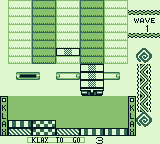
Game Boy (Hudson)
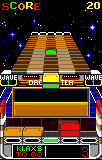
Atari Lynx
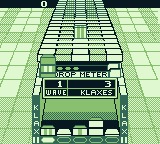
Game Boy (Tengen)
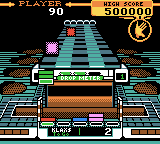
Game Boy Color
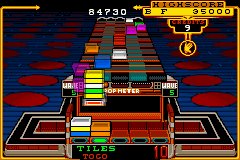
Game Boy Advance
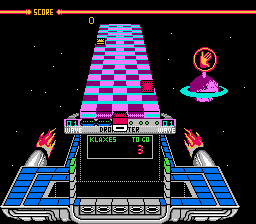
NES
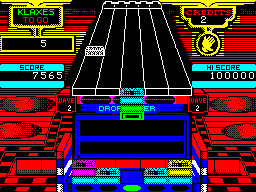
ZX Spectrum

BBC Micro
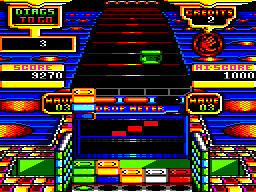
Amstrad CPC
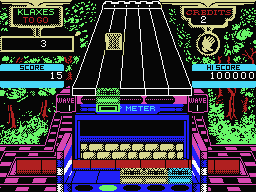
MSX

Genesis (Tengen)

Mega Drive (Namco)

Mega Drive VS (Namco)

Master System
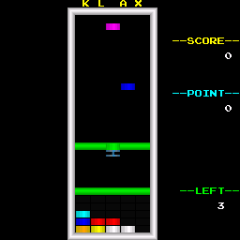
X68000 (Project M)
Spirtual Successor: Star*Burst / Star*Burst HD – iOS (2009)
Long, long after the last few ports of Klax came in, one of the game’s original designers, Mark Stephen Pierce, made a spiritual successor exclusive to Apple mobiles. While the graphics and the way the board is arranged are entirely new, gameplay wise, it appears to play very similarly to the original Klax. Of course, given the original game’s pick up and play nature, a game like Klax makes a fantastic fit for carrying around on your phone. Apparently, however, the game’s more modern nature asks to post on your Facebook a lot, which is always one of the bigger annoyances with these sorts of mobile games. Unfortunately, ports to any other consoles, handhelds, or computers seem unlikely.
